In today’s digital era, telemedicine app development has emerged as a game-changer in the healthcare industry. These apps have captured the attention of clinicians, hospitals, individual practices, and patients alike. The apps offer convenient and accessible medical consultations.
The telemedicine market has witnessed significant growth, with the US alone generating approximately $11.8 billion in revenue and 50% of hospitals adopting telemedicine programs (MarketWatch).
The scope of telemedicine has expanded beyond hospitals to encompass private medical practices, entrepreneurs, healthcare systems, and insurance companies.
As per Mordor Intelligence, the global IT healthcare market is projected to gain $20 billion by 2020, with telemedicine constituting a quarter of this total.
The rapid adoption of telemedicine apps raises the question: Why have these apps become indispensable in healthcare? Let’s explore the answer in detail in this blog.
Contents
- 1 What is a Telehealth App?
- 2 Types of Telehealth Apps
- 3 Real-Time Interaction
- 4 Remote Monitoring
- 5 Store-and-Forward
- 6 Why is Telemedicine App Development Achieving a Lot of Traction?
- 7 How to Make Sure HIPAA Compliancefor Telehealth Video Conferencing?
- 8 How to Develop a Telemedicine App?
- 9 Here’s What How Patient Dashboard Would Look Like
- 9.1 Patient Dashboard
- 9.1.1 1. Profile Creation: The Patient’s Digital Identity
- 9.1.2 2. Doctor Search: Your Personalized Physician Finder
- 9.1.3 3. Appointment Booking: A Virtual Receptionist
- 9.1.4 4. Real-time Consultations: The Virtual Clinic
- 9.1.5 5. Secure Payments: Your Digital Wallet
- 9.1.6 6. Instant Messaging: A Direct Line to the Doctor
- 9.1 Patient Dashboard
- 10 Access to Medical Records: A Personal Health Archive
- 10.1 1. Notifications: Your Assistant in Telemedicine Applications
- 10.2 2. Lab Test Booking: Your Virtual Lab Assistant in Telemedicine Mobile
- 10.3 Doctor’s Dashboard
- 10.4 1. Doctor Profile: Develop The Virtual Medical Portfolio
- 10.5 1. Appointment Management: The Digital Receptionist
- 10.6 2. Access to Electronic Medical Records (EMR): The Instant Medical Librarian
- 10.7 3. Digital Prescriptions: The Online Prescription Pad in Telemedicine Apps
- 10.8 4. Instant Messaging: The Virtual Consultation Room Applications
- 10.9 5. Video Consultations: The Digital Examination Room in Telemedicine App
- 10.10 6. Medical History Review: The Virtual Health Archive
- 10.11 7. Session Recording: The Digital Quality Assurance
- 10.12 8. Notifications: The Virtual Reminder in Software Development
- 11 Lab Technicians’ Dashboard in Telemedicine Apps
- 12 Admin’s Dashboard In Telemedicine App
- 13 What Are the Crucial Features of the Telehealth App?
- 13.1 1. Data Encryption and Security: The Digital Lock and Key
- 13.2 2. Video Conferencing: The Virtual Clinic
- 13.3 3. Instant Messaging: The Real-Time Health Helpline
- 13.4 4. Appointment Management: The Digital Planner
- 13.5 5. Clinical Documentation: The Virtual Medical Record
- 13.6 6. HIPAA Compliance: The Seal of Trust
- 14 Partner with Webisoft for Your Metaverse Journey
- 15 How Can Emerging Technologies Impact Telemedicine Apps Development?
- 16 Our Ready-To-Deploy Telemedicine App for Healthcare Organizations
- 17 Final Thought
- 18 Frequently Asked Questions
What is a Telehealth App?
A Telehealth app is a vital link between patients and healthcare providers, enabling them to engage and interact in a digital environment. These apps facilitate virtual consultations, empowering patients to connect with physicians from any location at their convenience.
Simultaneously, doctors can evaluate, diagnose, and manage many patient cases, including routine follow-ups and consultations. One of the remarkable advantages of telehealth apps is the minimal waiting time.
Patients typically wait only three minutes to connect with a physician through the telemedicine app. This eliminates the need for long hours in traditional waiting rooms, providing a more efficient and accessible healthcare experience.
Types of Telehealth Apps
Telehealth apps have evolved to cater to diverse healthcare needs, offering different functionalities and benefits.
1. Live Video Telehealth Apps
Live video telehealth apps enable real-time communication between patients and healthcare providers through video calls.
Patients can have face-to-face consultations and share symptoms from the comfort of their homes.
These apps support visual assessments and provide a more personalized and interactive healthcare experience.
2. Store-and-Forward Telehealth Apps
Store-and-forward telehealth apps facilitate the transmission of medical data, including images, test results, and patient records, from one healthcare professional to another.
Physicians can review the information and provide timely assessments and recommendations.
This app is useful for specialist consultations, second opinions, and complex medical cases.
3. Remote Patient Monitoring Apps
Remote patient monitoring apps enable healthcare providers to remotely monitor and track patients’ health conditions and vital signs.
Patients can use connected devices or wearables to collect and transmit data, such as blood pressure, glucose levels, and heart rate, to their healthcare providers.
This type of app is valuable for managing chronic conditions, post-operative care, and promoting proactive health management:
Real-Time Interaction
The heart of any telemedicine app is real-time interaction, the digital equivalent of an in-person doctor’s visit.
This type enables healthcare providers and patients to connect instantly. It allows immediate assessment, diagnosis, and treatment recommendations.
- Video/Audio Conferencing: Just like a physical consultation, healthcare providers can see and hear their patients, fostering a sense of personal connection.
The conversation happens in real time. It facilitates immediate responses and decisions, which can be crucial in emergencies or acute conditions.
Remote Monitoring
Remote patient monitoring (RPM) is another facet of telehealth apps that is particularly useful for patients with chronic conditions or those at high risk.
- Wearable Devices: Smartwatches, fitness bands, and health monitors can continuously track a patient’s health metrics like heart rate, blood glucose levels, blood pressure, and more.
This information can then be directly sent to healthcare professionals for analysis and prompt action if necessary.
- IoT-Enabled Health Sensors: The Internet of Things (IoT) has brought healthcare into the digital age. Sensors installed in the patient’s home can monitor their activity levels, sleep patterns, medication adherence, and fall detection.
It provides valuable data to healthcare providers about the patient’s health status and routine.
Store-and-Forward
Store-and-forward technology is vital when a healthcare provider needs to share a patient’s medical data with a specialist for further analysis.
- Sharing Medical Data: Healthcare providers can easily share crucial patient data such as blood tests, lab reports, X-rays, and other imaging studies. This is particularly useful when the specialist is in a different location, making it difficult or time-consuming for the patient to travel for a consultation.
- Collaborative Healthcare: Store-and-forward also allows for collaborative healthcare. Multiple healthcare providers can simultaneously access and analyze a patient’s information, facilitating a comprehensive treatment plan considering various medical opinions.
These different telehealth apps empower patients and healthcare providers to experience convenient, efficient, and collaborative healthcare services, regardless of location.
Why is Telemedicine App Development Achieving a Lot of Traction?
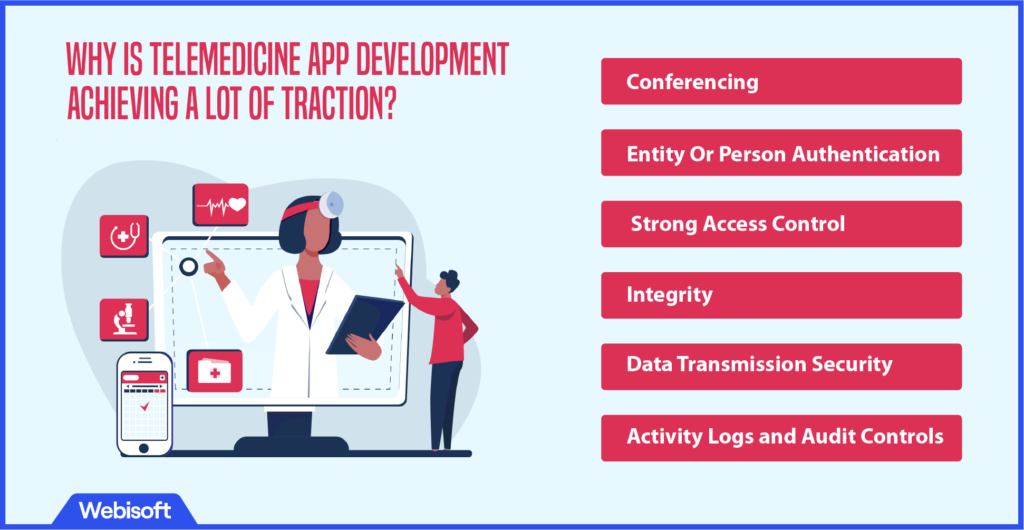
1. Conferencing
Navigating through the complexities of HIPAA compliance can seem daunting, but it’s an integral part of ensuring secure telemedicine services. Let’s break down each aspect and how it contributes to HIPAA compliance:
2. Entity Or Person Authentication
In the digital age, identity thefts are a recurring problem. Therefore, confirming an individual’s identity becomes vital before they gain access to sensitive information like electronically Protected Health Information (ePHI).
Strong authentication mechanisms are a cornerstone of a secure system. It ensures the person accessing the information is who they claim to be.
Biometric data provides a high level of authentication security, making it harder for unauthorized users to gain access. This could include:
- Fingerprint Identification: A person’s fingerprints are unique, and using this as a form of authentication ensures that only the person with the registered fingerprints can access ePHI.
- Keystroke Dynamics: The way an individual types on a keyboard is distinctive. Keystroke dynamics authentication measures the typing rhythm to verify the user’s identity.
- Facial Recognition: This method can effectively authenticate an individual by using complex algorithms to analyze facial features.
- Voice Commands: Each person has a unique voice pattern, and voice recognition software can be used to verify a person’s identity using their voice.
3. Strong Access Control
HIPAA enforces regulations that ensure ePHI is accessed only by authorized individuals. These measures can include:
- Unique User Identification: By assigning each user a unique name or number, the system can accurately track and identify users, ensuring only those granted access can view ePHI.
- Role-Based Access Control (RBAC): Not everyone needs access to all information in an organization. With RBAC, users are classified based on their roles, and permissions are set up to control who can access what, thus preventing unauthorized access.
4. Integrity
Data integrity must be maintained to ensure the ePHI isn’t unlawfully altered or destroyed. This can be achieved through end-to-end encryption, which ensures that data remains consistent and accurate during transfer.
5. Data Transmission Security
When sensitive PHI data is being transferred between participants, it becomes vulnerable. Measures like using AES-based algorithms for end-to-end encryption can be implemented to protect this data.
This safeguards the data, whether in transit (during transmission) or at rest (stored).
6. Activity Logs and Audit Controls
Keeping detailed activity logs and audit trails of all systems that have ePHI is a critical step towards HIPAA compliance.
These logs record access threads, modifications, and critical actions, which can help identify security violations or unlawful access to protected data.
In a nutshell, when developing telemedicine video conferencing solutions, we must ensure that all these requirements are met to maintain HIPAA compliance.
How to Make Sure HIPAA Compliancefor Telehealth Video Conferencing?
Video conferencing is a key telemedicine component, facilitating real-time interaction between healthcare providers and patients. However, it involves the digital exchange of personal health information.
It must adhere to the Health Insurance Portability and Accountability Act (HIPAA) regulations. These rules protect the integrity, confidentiality, and security of electronically protected health information (ePHI).
Non-compliance with HIPAA can lead to substantial penalties and may harm patient trust. Meeting these standards is crucial for successfully integrating telemedicine video conferencing solutions.
Here’s how we ensure HIPAA compliance when developing these solutions:
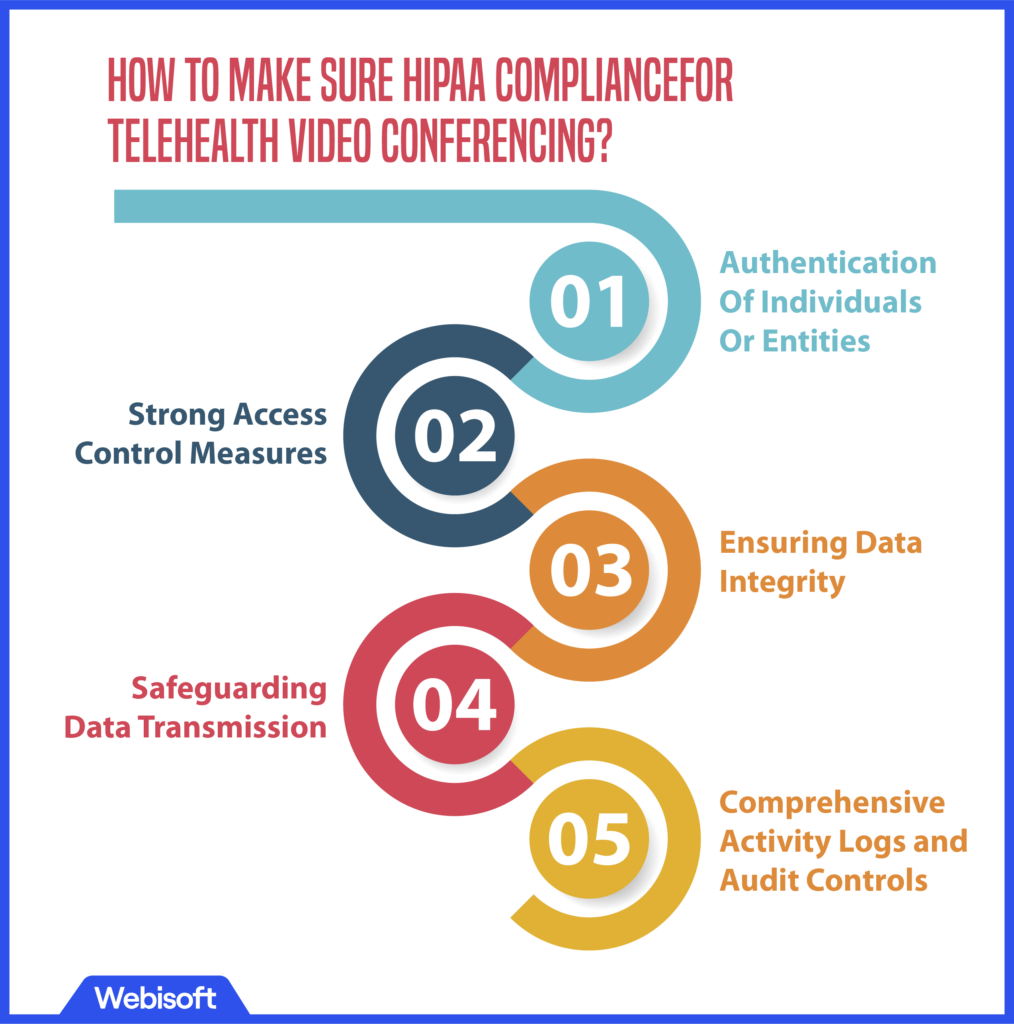
1. Authentication Of Individuals Or Entities
The first line of defence in securing ePHI is to confirm the identity of the person or entity requesting access. It’s vital to have a robust authentication mechanism in place to prevent unauthorized access.
- Biometric Authentication: We leverage unique physical or behavioural traits, such as fingerprints, facial recognition, keystroke patterns, or voice commands, to verify identities.
Given the difficulty in replicating such attributes, this method provides a higher security level than traditional password-based systems.
2. Strong Access Control Measures
HIPAA compliance requires that access to ePHI is limited strictly to those authorized.
- Unique User Identification: Assigning unique names or numbers for user identification helps trace and track user activities. Only those with specific permissions can access protected health information (PHI).
- Role-Based Access Control (RBAC): We classify users based on their roles and assign privileges and permissions accordingly. This method ensures that only the right individuals can access the necessary data, minimizing the risk of unauthorized data exposure.
3. Ensuring Data Integrity
Preserving the accuracy and consistency of ePHI is crucial. Any unauthorized alteration or data destruction can lead to serious patient safety issues.
- End-to-End Encryption: We implement end-to-end encryption to safeguard ePHI from tampering or alteration during transmission. This ensures that the data remains unaltered and secure from the point of origin to the point of consumption.
4. Safeguarding Data Transmission
The transmission of sensitive PHI data during a video conferencing session should be highly secure to prevent data breaches.
- End-to-End Encryption: We employ AES-based algorithms for data encryption, ensuring data security while in transit and at rest. This effectively prevents unauthorized third parties from intercepting and decoding the data.
5. Comprehensive Activity Logs and Audit Controls
Maintaining thorough audit trails and activity logs is mandatory for HIPAA compliance.
- Detailed Record Keeping: We log access threads, modifications, and other significant actions, which can help detect any security violations or unauthorized access to protected data.
- Audit Trails of Video Conference Sessions: We record all aspects of a video conference, including audio, video, and metadata, to create a comprehensive audit trail.
By meticulously adhering to these HIPAA compliance requirements, we guarantee the delivery of secure, reliable, and efficient telemedicine video conferencing solutions to healthcare organizations.
How to Develop a Telemedicine App?
When creating a telemedicine application, you’ll be dealing with four main categories of users:
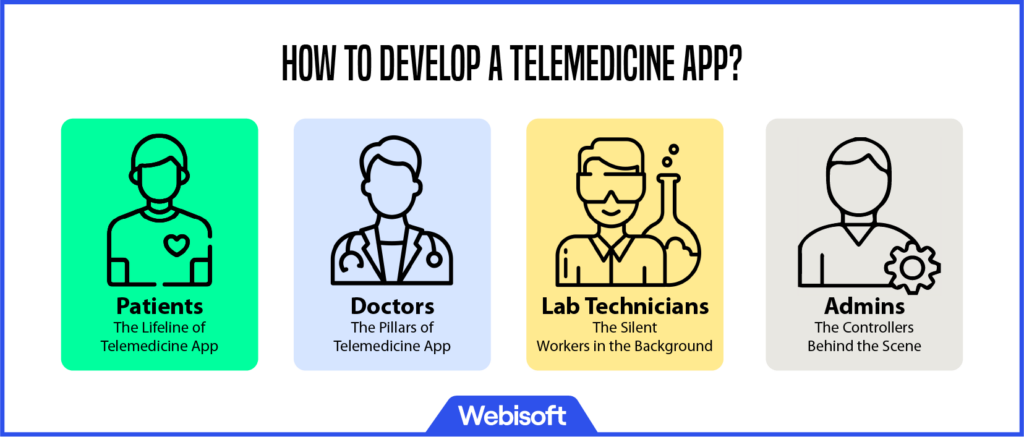
Patients – The Lifeline of Telemedicine App
Patients are the primary users of your telemedicine app. They initiate the online consultation, hence the need for a user-friendly interface.
The app should enable patients to provide crucial details, such as name, age, gender, medical history, and health concerns.
This information assists doctors in understanding their medical background and facilitating accurate diagnosis. Patients should choose a doctor who matches their needs and schedule an appointment.
The app should also provide a smooth, high-quality real-time audio and video consultation platform. The telemedicine app should provide multiple secure online payment options for their convenience.
In addition, they should be able to communicate with their doctors via instant messaging for additional queries.
Doctors – The Pillars of Telemedicine App
Doctors are the healthcare providers who interact with patients, provide online consultations, and ensure timely treatment. The application should allow doctors to set up professional profiles with relevant details about their specializations, qualifications, affiliations, and credentials.
Doctors need access to patient profiles, including their medical history and lab reports, for accurate diagnosis. Therefore, the app should provide an efficient tool to manage their schedule, view patient profiles, review medical records, and organize appointments.
Real-time chat functions and video consultations are necessary for effective communication with patients. Moreover, they should be able to prescribe treatments and medications via the app.
Lab Technicians – The Silent Workers in the Background
Lab technicians are pivotal in managing and sharing lab reports with doctors and patients. The app should facilitate lab technicians to create profiles, view patient test requests, and schedule them appropriately.
An essential feature would be the ability to assign tasks to other lab professionals for efficient workflow. The telemedicine app should also allow lab technicians to share lab reports directly with doctors and patients.
This can significantly speed up the treatment process by timely providing the necessary medical information.
Admins – The Controllers Behind the Scene
Admins are the individuals responsible for managing the overall functioning of the telemedicine app. They have administrative tasks, user management, and security control privileges.
The app should give admins access to all user information, the right to approve or remove user profiles and edit existing user data.
Here’s What How Patient Dashboard Would Look Like
Patient Dashboard
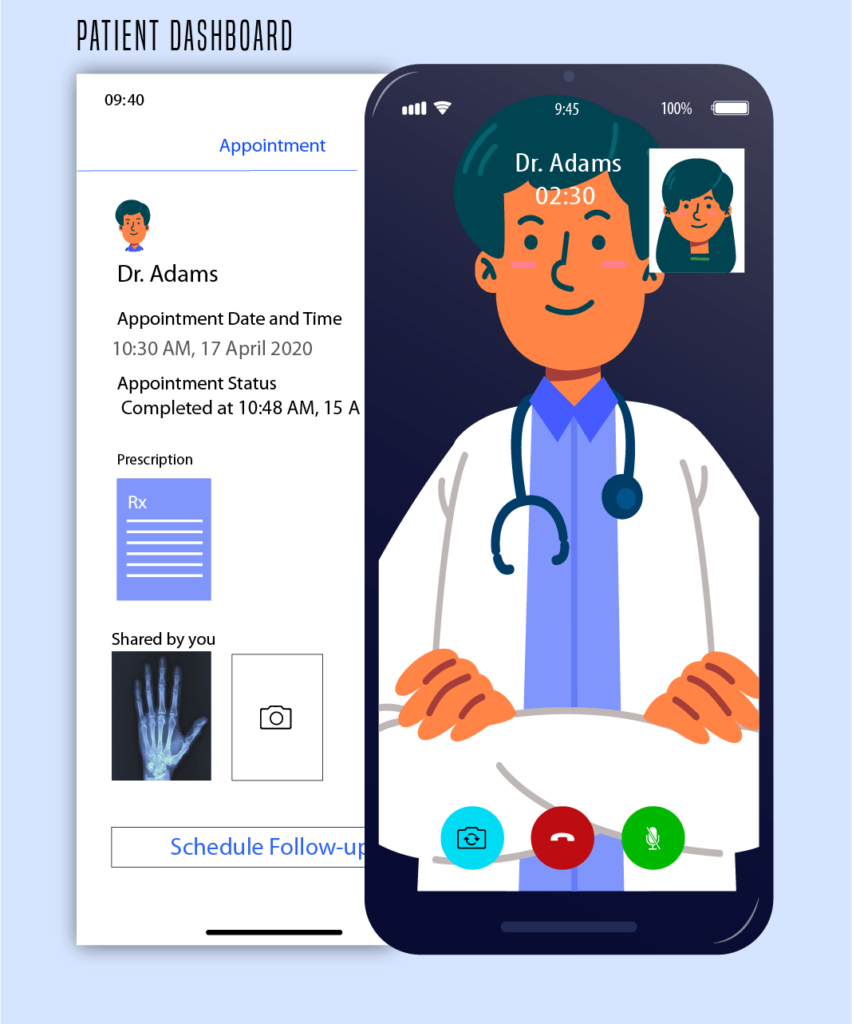
Creating a robust and intuitive dashboard for patients is paramount in telemedicine app development. The patient dashboard is their central hub for interactions and medical transactions within the app. Let’s examine the key features that should be part of a patient dashboard:
1. Profile Creation: The Patient’s Digital Identity
The app should allow patients to create a profile where they input their vital details such as name, age, gender, contact information, and medical history.
This data forms the backbone for personalized treatment and should be editable at any time to reflect changes in the patient’s health status or personal information.
2. Doctor Search: Your Personalized Physician Finder
A doctor search feature is essential to connect patients with the right healthcare provider. It should include filters like specialization, gender, language, and insurance provider. It empowers patients to find a physician that meets their needs and preferences.
3. Appointment Booking: A Virtual Receptionist
An intuitive tool to schedule appointments allows patients to view doctors’ profiles and check their availability. This feature should offer an easy-to-navigate calendar view where patients can select an available slot and book an appointment with the doctor of their choice.
4. Real-time Consultations: The Virtual Clinic
The telemedicine app should support high-quality audio and video calls, enabling patients to consult with doctors remotely.
This feature should deliver a seamless and secure experience, allowing doctors to identify signs and symptoms accurately.
5. Secure Payments: Your Digital Wallet
The app should provide multiple secure online payment options for a smooth transaction process. It enables patients to pay for their visits conveniently.
The system applications should be straightforward, easy to use, and offer various payment methods to suit user preferences.
6. Instant Messaging: A Direct Line to the Doctor
An efficient instant messaging feature will allow patients to communicate with their doctors in real time.
This function should support sharing queries, discussing symptoms, and clarifying treatment plans. The telemedicine applications contributes to develop a comprehensive patient-doctor communication system.
Access to Medical Records: A Personal Health Archive
Past medical records are crucial for new consultations or treatment follow-ups. The app should enable patients to access their previous medical history easily.
This feature supports new medical providers in delivering effective treatment by offering immediate access to records.
1. Notifications: Your Assistant in Telemedicine Applications
The app should provide timely notifications to help patients keep track of their appointments and any changes.
Alerts about upcoming appointments, appointment confirmations, or rejections can help manage schedules. And these alerts help to prevent any misunderstandings or missed consultations.
2. Lab Test Booking: Your Virtual Lab Assistant in Telemedicine Mobile
The patient dashboard should also include a feature to book lab tests as the doctor advises. This functionality allows patients to request lab services conveniently, ensuring they follow through with all necessary diagnostic procedures for their treatment plan.
Doctor’s Dashboard
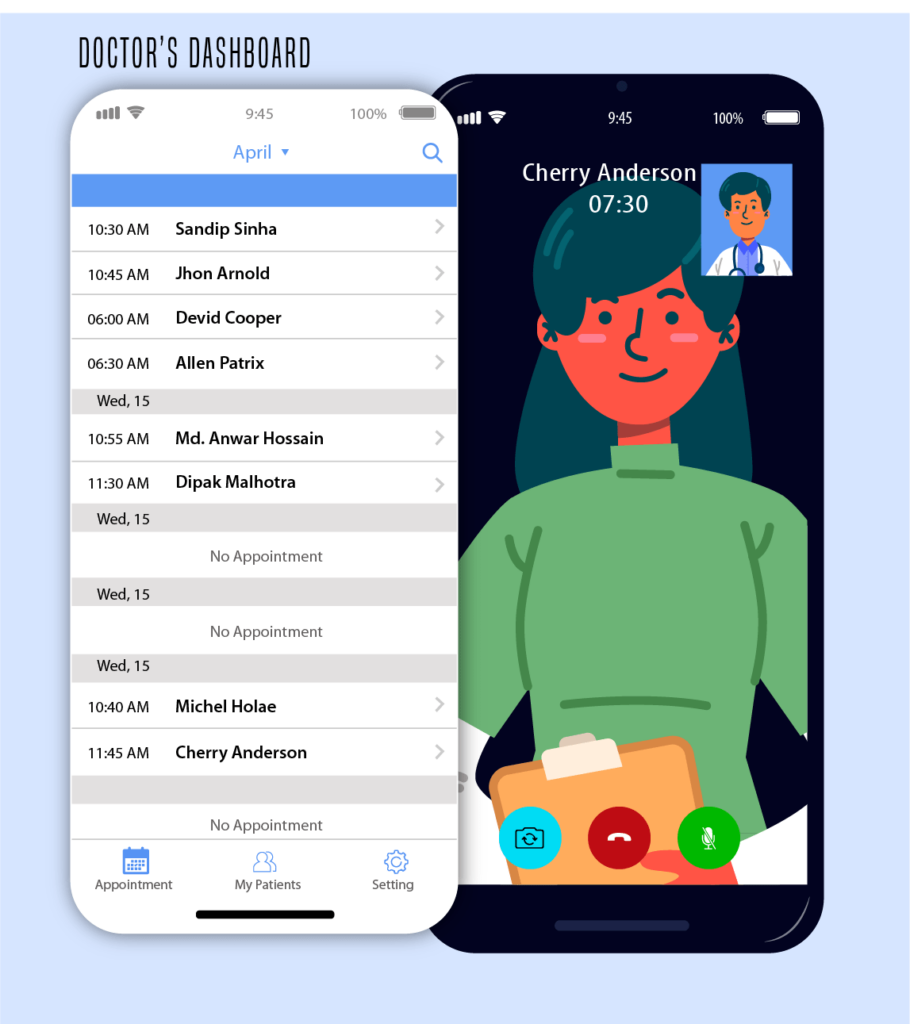
The telemedicine app should be equipped with comprehensive tools that cater to healthcare providers.
This helps in providing efficient and effective remote healthcare services. Let’s unpack the key features of a well-designed doctor’s dashboard:
1. Doctor Profile: Develop The Virtual Medical Portfolio
Doctors should be able to set up detailed profiles showcasing their qualifications, certifications, specializations, and affiliations.
This feature not only establishes their credibility but also aids patients in choosing the right healthcare provider.
1. Appointment Management: The Digital Receptionist
A flexible and robust appointment management feature is essential. Doctors should be able to adjust their schedules, confirm or reject appointment requests, and manage their daily availability. This tool makes managing patient interactions much more efficient.
2. Access to Electronic Medical Records (EMR): The Instant Medical Librarian
Integrating existing EMR systems can give doctors real-time access to patient’s medical records and lab reports.
This critical feature ensures doctors have all the necessary information at their fingertips when making diagnoses or prescribing treatments.
3. Digital Prescriptions: The Online Prescription Pad in Telemedicine Apps
The telemedicine app should facilitate doctors to prescribe treatments and medications directly within the app.
This feature simplifies the prescription process. It enables patients to receive and fill their prescriptions more quickly and conveniently.
4. Instant Messaging: The Virtual Consultation Room Applications
A real-time chat function can empower doctors to respond to patient inquiries, provide advice, or clarify any treatment-related doubts quickly and efficiently.
5. Video Consultations: The Digital Examination Room in Telemedicine App
High-quality video consultations are essential in a telemedicine app. This feature allows doctors to assess patients remotely, providing effective treatment while ensuring the comfort and safety of patients.
6. Medical History Review: The Virtual Health Archive
A feature allowing doctors to review their patient’s medical history is vital. Doctors can provide more personalized and effective treatment plans with easy access to this information.
7. Session Recording: The Digital Quality Assurance
The capability to record consultations is important for quality control and provides a layer of protection in case of disputes. This feature ensures transparency and accountability in the provision of healthcare services.
8. Notifications: The Virtual Reminder in Software Development
Timely notifications about upcoming appointments or patient requests ensure smooth operation and timely patient care through telemedicine apps. This feature in telemedicine apps keeps doctors updated about their schedules and helps them plan their day more effectively.
Lab Technicians’ Dashboard in Telemedicine Apps
In telemedicine app development, catering to the specific needs of lab technicians is equally essential.
The Lab Technician Dashboard must provide functionalities that simplify managing lab reports and tasks applications. Let’s delve into the essential features that must be incorporated:
1. Profile Creation: Establishing the Lab Technician’s Digital Identity
Lab Technicians should have a dedicated space within the telemedicine apps to create their profiles. Telemedicine app developer can input vital information, such as their qualifications, license details, and work background.
The telehealth app development helps establish credibility and allows for easier communication between patients, doctors, and lab technicians.
1. Request Viewer: The Digital Request Manager
The app should provide a feature allowing lab technicians to view patient test requests.
They should be able to manage these requests efficiently, add them to their work schedule, and track their progress. This tool simplifies the workflow and makes the task of lab technicians more manageable.
2. Task Delegation: The Virtual Task Assigner
For efficient workflow management, the telemedicine app should allow lab technicians to delegate tasks to other professionals within the lab.
Lab technicians can assign tasks based on the test requests received from patients. It ensures that samples are collected and tested promptly.
3. Report Sharing: The Digital Report Distributor
The most critical feature for lab technicians is the ability to share lab reports directly with doctors and patients via the telemedicine app or web app.
This feature speeds up the treatment process, as the required medical information reaches the concerned individuals promptly. It should also ensure the reports are shared securely to maintain patient confidentiality.
Admin’s Dashboard In Telemedicine App
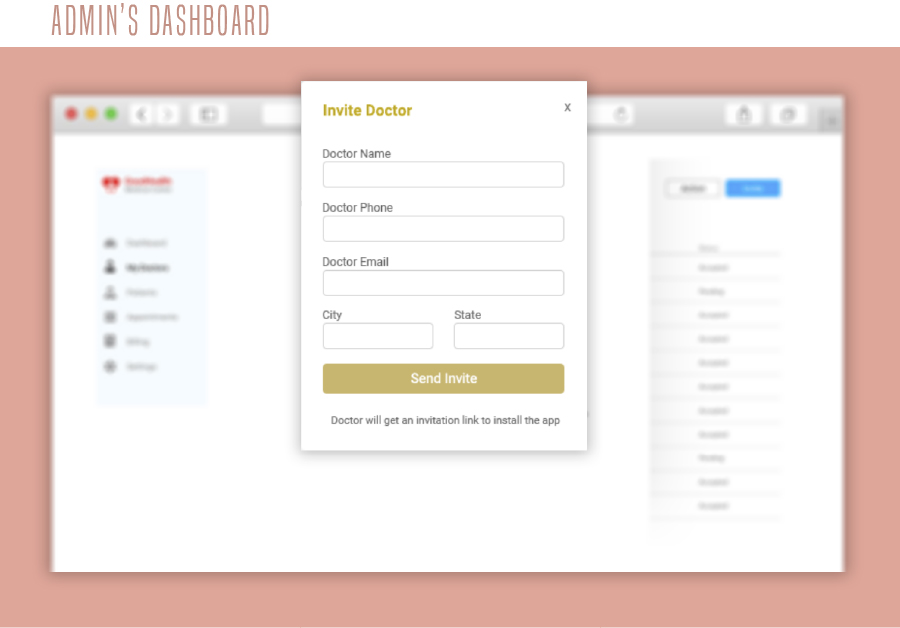
The Admin Dashboard plays a pivotal role in managing the telemedicine app efficiently. The command centre oversees every activity, ensures smooth operations, and maintains the system’s security. Let’s delve deeper into the crucial features this dashboard should host:
1. User Management: The Virtual Supervisor
Admins should be able to manage all app users effectively. They should have the authority to oversee user activity, edit existing information, and remove users if necessary.
This feature helps maintain the platform’s credibility and ensures that only qualified professionals serve the users.
Documentation Control: The Digital Document Handler
Access to all essential documents related to patient care, lab test reports, medical records, and insurance is crucial for admin roles. This feature aids in taking evidence-based decisions and creating patient registry functions.
It provides evidence for legal records and researching large patient populations efficiently. Moreover. It ultimately helps in refining the app’s operations and improving its services.
Data Reports: The Smart Analyst
Using artificial intelligence, data collected from the telemedicine app can be transformed into valuable insights through reports.
Admins should be able to review these reports and extract actionable information to make critical decisions. They can decide on app enhancement, user engagement, and overall system performance.
Financial Management: The Virtual Finance Manager
The admin dashboard should provide a comprehensive financial flow management feature. It includes tracking income and expenses, generating and sending online invoices, and accepting online payments.
This financial management tool can help admins make data-driven business decisions and ensure the financial stability of the platform.
What Are the Crucial Features of the Telehealth App?
As you navigate the path of telemedicine app development, it’s crucial to incorporate certain key features to ensure your app is efficient, user-friendly, and secure. Let’s delve into the indispensable elements you need to consider:
1. Data Encryption and Security: The Digital Lock and Key
Securing patient data should be a top priority. Incorporate advanced encryption and security protocols to safeguard sensitive information, ensuring user trust and legal compliance.
2. Video Conferencing: The Virtual Clinic
Facilitate personal interactions between doctors and patients through high-quality video conferencing. This face-to-face communication is key to accurate diagnoses and effective patient-doctor relationships, making it a must-have feature.
3. Instant Messaging: The Real-Time Health Helpline
Instant messaging is an effective communication tool between patients and doctors, allowing for quick queries, clarifications, and follow-up discussions. It ensures communication never becomes a barrier to quality healthcare.
4. Appointment Management: The Digital Planner
Empower patients with the ability to manage their appointments based on doctor availability. This feature simplifies the booking process and enhances the overall patient experience.
5. Clinical Documentation: The Virtual Medical Record
Securely handling patient records while maintaining privacy is critical in a telemedicine app. A feature that allows safe storage and access to clinical documentation ensures efficient patient care.
6. HIPAA Compliance: The Seal of Trust
Implementing HIPAA compliance is crucial to safeguarding the electronic communication of healthcare transactions. This legal requirement also instils trust among users about your commitment to their privacy and data security.
Building a telemedicine app involves a patient-centric approach, factoring in user experience, security, and convenience. By incorporating these essential features, you’ll create an app as a reliable virtual bridge between healthcare providers and patients.
Partner with Webisoft for Your Metaverse Journey
Webisoft is your ideal ally in launching your metaverse project, offering comprehensive development solutions and expertise. Let’s explore how Webisoft can bring your metaverse vision to life.
1. Expertise in Metaverse Development
Webisoft is at the forefront of metaverse development, leveraging cutting-edge technologies and innovative strategies. Our team of skilled developers, designers, and strategists has extensive experience creating immersive virtual environments.
They seamlessly blend augmented reality (AR), virtual reality (VR), and mixed reality (MR) elements. With a deep understanding of the metaverse’s potential, we can help you craft unique experiences that captivate and engage your audience.
2. Tailored Solutions for Your Metaverse Project
At Webisoft, we believe in delivering tailor-made solutions that align with your specific metaverse project requirements.
Whether you envision a virtual world, an interactive AR experience, or a mixed-reality application, we can turn your ideas into reality.
Our team works closely with you, from conceptualization to development and deployment, ensuring a customized solution.
3. Cutting-Edge Technologies for Immersive Experiences
Webisoft stays abreast of technological advancements to provide the most immersive and captivating metaverse experiences.
We leverage state-of-the-art tools, platforms, and frameworks, including Unity, Unreal Engine, ARKit, ARCore, and WebXR, to create stunning visuals, seamless interactions, and dynamic environments.
Our technical expertise and creative mindset allow us to push the boundaries of what’s possible in the metaverse.
4. End-to-End Metaverse Development Services
Webisoft offers end-to-end metaverse development services to streamline your project from start to finish. Our comprehensive range of services includes:
- Concept Development:
- We collaborate closely with you to understand your metaverse vision and conceptualize ideas that align with your goals.
- Our team conducts in-depth research and analysis to identify the optimal technological approach and user experience strategies.
- We collaborate closely with you to understand your metaverse vision and conceptualize ideas that align with your goals.
- Design and Development:
- Our designers and developers work hand-in-hand to create visually stunning and interactive metaverse environments.
- We focus on user-centric design principles and ensure seamless features, functionalities, and immersive elements integration.
- Our designers and developers work hand-in-hand to create visually stunning and interactive metaverse environments.
- Integration and Interoperability:
- We specialize in integrating metaverse solutions with existing systems and platforms to ensure interoperability and seamless user experiences.
- Our team ensures smooth data exchange, connectivity, and compatibility across various devices and platforms.
- We specialize in integrating metaverse solutions with existing systems and platforms to ensure interoperability and seamless user experiences.
- Testing and Quality Assurance:
- Rigorous testing and quality assurance processes are implemented to ensure your metaverse project’s performance, stability, and security.
- We conduct extensive testing across multiple devices and scenarios to deliver a flawless user experience.
- Rigorous testing and quality assurance processes are implemented to ensure your metaverse project’s performance, stability, and security.
- Deployment and Support:
- Webisoft assists in deploying your metaverse project across platforms, ensuring a smooth transition to the live environment.
- We provide ongoing support and maintenance services to address issues, update content, and optimize performance.
Embarking on your metaverse project requires a trusted partner who understands the intricacies of immersive experiences and cutting-edge technologies.
With Webisoft, you gain access to a dedicated team of experts. They will guide you through the entire development process, from ideation to deployment. Launch your metaverse project with Webisoft and unlock the limitless possibilities of the virtual realm.
Together, let’s create extraordinary metaverse experiences that captivate and inspire.
How Can Emerging Technologies Impact Telemedicine Apps Development?
1. Artificial Intelligence
Artificial Intelligence (AI) coupled with telemedicine paves the way for more accurate diagnoses and cost savings. AI’s role in transforming healthcare is undeniable.
A study conducted by TCS among 56 esteemed healthcare organizations revealed that 86% of these organizations are leveraging AI, with projected spending of around $54 million by 2020.
For instance, Google’s Machine Learning Algorithm is already being employed by doctors to treat and diagnose diabetic retinopathy remotely.
Let’s delve into how AI can revolutionize telemedicine app development:
- AI for Treatment Suggestions IBM Watson, a machine learning powerhouse, is proving invaluable in healthcare. At a 327-bed hospital in Jupiter, Florida, it recommends cancer treatment plans based on machine learning.
The machine learning-based system provides physicians with clinically accurate data that has been verified and corrected.
Incorporating machine learning algorithms like IBM Watson into telemedicine applications allows for superior diagnoses with reduced human intervention.
An example would be an algorithm that monitors treatment progress for a specific disease and then asks patients about their average recovery time. Such a platform could help doctors suggest treatments grounded in historical success rates.
- AI Aid in Elder Care Gartner’s research predicts that telehealth will evolve into robotic forms, extending a helping hand in home healthcare. As demand surpasses the supply of home healthcare workers, smart machine robots are emerging as a pragmatic solution.
Eldercare-assistive robots, capable of moving semi-autonomously and with sensors to navigate environments, are noteworthy examples of home telehealth technology.
Japan’s government has invested in developing robots to assist older people in daily tasks like walking, bathing, and waste disposal. A robot named “IBA”, for example, employs smart rubber sensors to determine an elderly person’s weight without having to lift them.
- AI for Improved Diagnoses Doctors can leverage telemedicine apps to monitor, diagnose, and treat patients from afar. Machine learning amalgamates with remote monitoring.
These apps can facilitate better diagnoses with fewer specialists. Startups like “FDNA” are exploring the use of machine learning algorithms to identify rare genetic disorders from patients’ facial photos, potentially reducing the need for multiple doctor visits.
2. The Potential of IoT
IoT holds the potential to significantly boost the efficacy of telemedicine app development, often surpassing the quality of care achievable through traditional in-person methods.
- Medical Device Data Acquisition Despite the strides in telemedicine, certain limitations persist. During a video conference, physicians can spot a rash or identify symptoms such as pallor or sweating. But they can’t directly measure a patient’s blood pressure or heartbeat.
Usually, doctors must rely on patients to take these readings home if they have the necessary equipment.
An innovative company, “CyberMed,” proposes merging telemedicine with IoT. It will enable patients to use medical devices created for the company’s patients.
Devices like pulse oximeters and digital stethoscopes can be purchased and used during telemedicine consultations. The gathered data can be sent to the cloud for the doctor’s evaluation.
- Remote Monitoring Capabilities The absence of proper health monitoring facilities often plagues people in rural areas.
However, IoT-powered wireless sensors can enable health monitoring for these populations. These smart sensors can securely collect and analyze patient data. And then share the information with relevant health professionals.
Our Ready-To-Deploy Telemedicine App for Healthcare Organizations
We’ve crafted a robust, user-friendly telemedicine app. It’s a ready-to-go solution that can be tailored and launched within weeks.
It offers various communication channels, including video, text, and audio chat. Patients can schedule virtual appointments with doctors based on their availability. Our app is particularly tailored for healthcare institutions.
It seamlessly integrates with their workflow and paves the way for more consultations. However, it’s not a marketplace app; rather, it connects patients with their existing doctors using the app’s invite feature. This setup helps doctors retain their patients, facilitating remote communication via the telemedicine app.
We prioritize data security and confidentiality. Hence we’ve integrated 256-bit encryption using SSL for in-app communication. This ensures the safe storage of health records. Moreover, the app is fully compliant with healthcare regulations and standards. To learn more about our ready-to-launch telemedicine app, click here.
Final Thought
Crafting a successful telemedicine app development requires meticulous attention to detail. It encompasses feature selection, technological considerations, and adherence to legal requirements in your target regions.
One crucial aspect that can enhance the credibility and appeal of your telemedicine app to users is the inclusion of comprehensive information about each doctor and the option for patients to rate and review their experiences.
If you are seeking a reliable technology partner to develop your telemedicine application, our expertise can assist you in building a tailored solution.
We can deliver whether you require a minimal viable product (MVP) or an enterprise-grade telemedicine platform that seamlessly integrates with your existing healthcare system.
At Webisoft, we specialize in telemedicine app development, crafting solutions that connect patients and healthcare professionals effortlessly. Don’t let distance be a barrier to quality healthcare. Contact us today and let’s revolutionize healthcare access together!
Frequently Asked Questions
What Technologies Are Commonly Used in Telemedicine App Development?
Telemedicine apps often utilize real-time video conferencing, secure data transmission, and cloud storage for medical records. Artificial intelligence (AI) can also be employed for features like symptom assessment or chatbot support.
What Are the Challenges in Telemedicine App Development?
Some challenges in telemedicine app development include ensuring data security and privacy and addressing regulatory compliance requirements. The other challenges are integrating with existing healthcare systems, designing a user-friendly interface etc.
